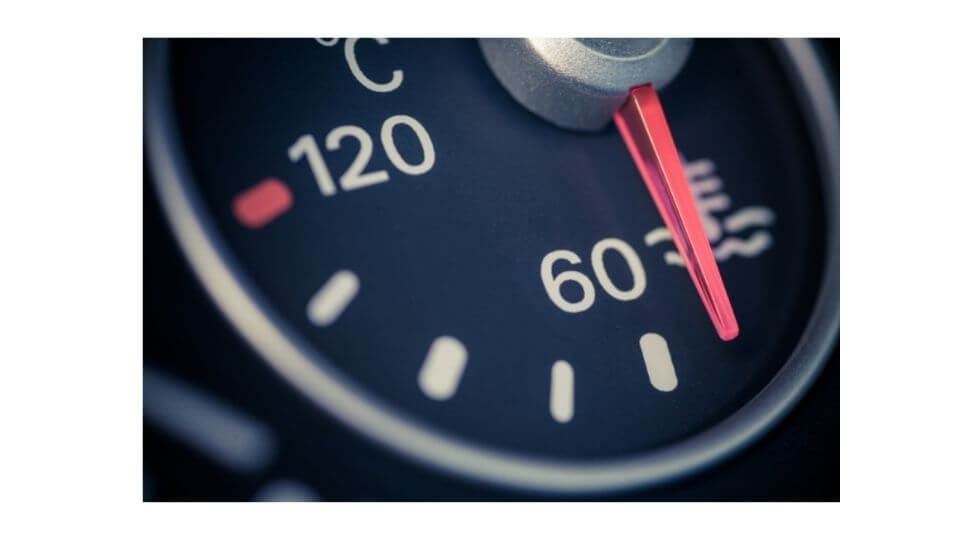Wondering why your Jeep wrangler temperature gauge fluctuates? Well, in this article we are going to be giving you reasons why this is happening and ways for you to fix this issue so let’s jump into it.
Though it’s not a very common problem, some Jeep Wrangler owners have had the experience of the temperature gauge behaving erratically. It moves up and down in a very random manner.
The ideal situation you can expect with a Jeep Wrangler temperature gauge is for it to be sturdy. When it moves up and down, it’s a sure sign that there is a problem that needs to be fixed quickly before worse, more expensive damage to your Wrangler. So what causes this problem?
In short, the Jeep Wrangler Temperature Gauge fluctuates because of a faulty, thermostat, air bubble in the cooling system, failing radiator fan, leaking cylinder head gasket, insufficient coolant level, or a faulty gauge.
Let’s dive a little deeper and look at each of these problems individually.
Why Does My Jeep Wrangler Temperature Gauge go Up and Down?
There are a number of reasons that this may happen and in order to apply the right remedy, you will need to make the right diagnosis.
Getting things right at this stage will help you avoid randomly changing out parts or doing something that will make the situation worse. Here are some possible causes and solutions.
1. Faulty Thermostat
This is one of the first places to look when you are trying to diagnose the problem. The thermostat is responsible for regulating the engine temperature and keeps it at the optimum temperature.
This ranges from 180°F to about 200°F. When the engine reaches this range, the thermostat opens up and allows coolant in to cool the engine and keep temperatures within optimum levels.
When a thermostat is faulty, two things may happen.
Thermostat Stuck Shut
The first scenario is when the thermostat is stuck shut. When the engine temperature reaches the above threshold, the faulty thermostat remains shut and doesn’t allow the coolant in. This leads to the engine overheating and possibly catastrophic engine failure.
Thermostat Stuck Open
The opposite may also happen where the thermostat is stuck in an open position. When this happens, the coolant is released long before the engine reaches optimum temperature. The result is increased emissions and faster engine wear. The temperature gauge will also continuously be on cool.
How to Fix a faulty thermostat
If you suspect that your thermostat is faulty, you need to make sure before replacing it. There are some clearly visible signs that are very easy to detect. You can make a visual inspection of your thermostat.
If you see leaking transmission fluid around it or on the ground, there is a high likelihood that you have a faulty thermostat. If there are clearly visible signs like the ones described above, you can take the following steps: Remove the radiator cap and start the engine.
If the coolant moves immediately, your thermostat is stuck open. Under normal circumstances, it should take 10 to 20 minutes for the engine to get to the right temperature before the coolant starts moving.
If, after 10 to 20 minutes, the coolant does not move and the engine has reached optimum temperature (you may need a thermometer to measure engine temperature) the thermostat is stuck shut.
These are clear signs of a faulty thermostat and it needs to be replaced. The good news is that it’s pretty easy to do and the thermostat is pretty affordable. Just make sure to get a quality one if you want to avoid a similar or possibly worse scenario.
When you replace your thermostat, don’t just top it off with coolant. Make sure that you flush out the old coolant first then replace it. This is because some corrosion would have taken place and the old coolant is now contaminated.
2. Air Bubble in the Cooling System
Another common cause of your temperature gauge going haywire is when air is trapped inside the engine cooling mechanism. It happens when air is trapped inside the radiator.
Sometimes it is characterized by a bubbling sound that sounds like a waterfall. Though Wranglers are said to have an internal mechanism that gets rid of these air pockets, it doesn’t always work as it is supposed to.
When there is an air bubble issue, the engine temperature rises when the vehicle is stationary and idling but will go down when the car starts moving again.
The temperature gauge will, however, not maintain one position but will move up and down in a haphazard manner.
How to Fix Trapped Air Bubbles
To fix a trapped air bubble, you need to remove the radiator cap then lift the front section of the vehicle on a ramp or park it at an incline. Start the car and let it idle. As the engine heats up and the radiator hose softens, squeeze it a number of times.
You should hear a burping sound as the air bubble is released. Put back the radiator cap and drive the car around to see if the problem is still there. Burping should fix the problem and the temperature gauge should be steady again. If the problem persists, it could be any of the following issues.
3. Leaking Cylinder Head Gasket
This problem usually results from an overheated engine. The resultant damage to the cylinder head gasket leads to coolant leaking and mixing with the oil.
The resultant mixture is not suitable for lubricating the engine properly. When this happens the engine will suffer permanent damage if the problem is not solved quickly.
How to Fix a leaking Head Gasket
When you notice that the cylinder head gasket is damaged, replace it. You will also need to bleed out all the oil and coolant and replace it.
4. Failing Radiator Fan
Another reason for your temperature gauge acting up could be a faulty radiator fan. When this is not working, the engine temperature will not regulate efficiently leading to overheating of the engine. This can lead to permanent engine damage.
How to Fix this Problem
Replace the faulty radiator fan immediately as any delay in doing so will lead to a larger bill down the line.
5. Faulty Temperature Gauge
Finally, a possible reason for your gauge acting up could be just because it is faulty. If you’ve done all the tests in this article and still haven’t fixed the problem, the cause could be a faulty gauge.
How to Fix this Problem
To establish whether or not this is the cause, you will need to run some tests on the temperature gauge. The temperature sensor may not be functioning properly.
You can quickly establish this by buying a temperature sensor and testing whether there is a difference. Fortunately, pressure sensors are not very expensive and you can get a good quality one for between $8 and $15. Be careful not to use store brands but buy the OEM version used on Jeeps.





